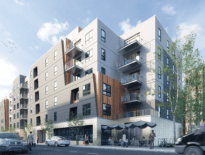The Suffolk Superior Court dealt a major setback in April to The Chiofaro Co,’s proposed 600-foot mixed-use tower at the Harbor Garage site near the New England Aquarium in Boston.
Chiofaro proposes to develop a project on filled tidelands within 100 feet of Boston Harbor’s high-water mark. The site is subject to Chapter 91 of the Massachusetts General Laws, which requires the Massachusetts Department of Environmental Protection (DEP) to ensure that Chiofaro’s project accommodates water-dependent uses and other public purposes.
As required under Chapter 91, DEP promulgated waterways regulations that impose a basic 55-foot height limit on projects within 100 feet of the high-water mark. However, DEP regulations allow taller buildings in cities and towns that adopt “municipal harbor plans” approved by the Massachusetts Executive Office of Energy and Environmental Affairs (EOEEA). Several municipalities have adopted municipal harbor plans, including Boston, Gloucester, Salem and Provincetown. EOEEA approved Boston’s Downtown Municipal Harbor Plan (Downtown MHP) in 2018, opening the possibility for Chiofaro’s 600-foot building.
The Conservation Law Foundation and residents at the nearby 400-foot-high Harbor Towers oppose the increased building height. In addition, Harbor Towers residents do not want to lose parking rights at the existing garage. After EOEEA approved the Downtown MHP, CLF and Harbor Towers residents filed separate suits in Superior Court against EOEEA, DEP and Chiofaro’s development subsidiary, claiming, among other things, that DEP had wrongfully delegated its Chapter 91 authority to regulate tidelands developments to EOEEA. CLF and the Harbor Towers residents argued that DEP’s delegation to EOEEA was ultra vires, that is, beyond DEP’s statutory authority. They claimed that EOEEA’s approval of the Downtown MHP was a nullity.
Targeting the Regulatory Framework
CLF and the Harbor Towers residents realized that if they could persuade the court to nullify the Downtown MHP, there would be no regulatory framework allowing Chiofaro to develop a 600-foot building. Chiofaro’s project would instead be limited to the 55-foot height allowed under DEP’s other regulations.
Chiofaro, EOEEA and DEP initially moved to dismiss both lawsuits. In 2019, the court dismissed most of CLF’s and the Harbor Towers residents’ claims, but not their claims that DEP wrongfully delegated its regulatory authority to EOEEA regarding the Downtown MHP.
After surviving the motions to dismiss, CLF and the Harbor Towers residents filed motions for summary judgment against EOEEA’s approval of the Downtown MHP. Chiofaro, EOEEA and DEP filed opposing cross-motions for summary judgment. The Superior Court ruled in favor of CLF and the Harbor Towers residents on April 1.
From 55 Feet to 600 Feet
In making its decision, the court noted that Chapter 91 is intended to preserve the public’s ancient rights to use the commonwealth’s waterways and tidelands for fishing, fowling and navigation. Chapter 91 specifically delegates this responsibility to DEP, and authorizes only DEP to issue regulations that protect the public’s rights to waterways and tidelands.
The court then discussed relevant DEP regulations involving developments on filled tidelands and municipal harbor plans. The court noted that DEP regulations impose a 55-foot height limitation on non-water-dependent developments within 100 feet of the high-water mark, which limit can be increased one-half of a foot for each additional foot of separation from the high water mark.
However, DEP regulations allow an exemption for projects confirming to municipal harbor plans that EOEEA has approved, such as the Downtown MHP. In this case, the Downtown MHP would allow Chiofaro’s project to rise more than 10 times higher than the 55-foot height otherwise allowed under DEP regulations.
Will Win Last?

Christopher Vaccaro
The court noted that Chapter 91 delegates regulatory authority to DEP, not EOEEA. Therefore, DEP’s further delegation of authority to EOEEA to approve the Downtown MHP was invalid. The court ruled in favor of CLF and the Harbor Towers residents, declaring that DEP regulations relinquishing DEP’s regulatory authority to EOEEA for municipal harbor plans are invalid and ultra vires. As a result of this ruling, EOEEA has no authority to make determinations for DEP’s licensing of tidelands projects within the Downtown MHP, and EOEEA’s decisions on the Downtown MHP are null and void.
CLF’s and the Harbor Towers residents’ victory in this case may only be temporary. The court’s decision calls into question municipal harbor plans in other cities and towns besides Boston. Accordingly, DEP is likely to revise its regulations to eliminate the delegation to EOEEA.
If that happens, Chiofaro is expected to resume efforts to build the 600-foot project, and CLF and the Harbor Towers residents will be back with another list of grievances to stall the project.
Christopher R. Vaccaro Esq. is a partner at Dalton & Finegold L.L.P. in Andover. His email address is cvaccaro@dfllp.com.






